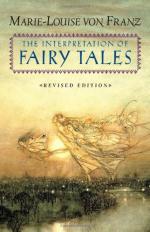
|
| Name: _________________________ | Period: ___________________ |
This test consists of 15 multiple choice questions and 5 short answer questions.
Multiple Choice Questions
1. In Chapter 1, Von Franz writes that fairy tales "are the purest and simplest expression of collective ______ psychic processes."
(a) Conscious.
(b) Aware.
(c) Dreaming.
(d) Unconscious.
2. What term refers to the "ups and downs" of a story?
(a) Peripeteia.
(b) Logos.
(c) Lysis.
(d) Middle.
3. How many "functions of consciousness" are there in Jungian psychology?
(a) 2.
(b) 6.
(c) 4.
(d) 5.
4. Von Franz establishes that the first step in evaluating a fairy tale is to determine its what?
(a) Symbolism.
(b) Theme.
(c) Setting.
(d) Characters.
5. In Von Franz' metaphor for myth and fairy tale, what might local sagas or myth be?
(a) Flesh.
(b) Water.
(c) Earth.
(d) Sand.
6. Who contended that fairy tales were of Babylonian origin?
(a) Sigmund Freud.
(b) E. Stuck.
(c) Theodor Benfey.
(d) Alexander Payne.
7. What term is synonymous with Carl Jung's central psychological archetype, the unified consciousness and unconsciousness?
(a) Id.
(b) Super-ego.
(c) Ego.
(d) Self.
8. Which Egyptian god was associated with the falcon?
(a) Horus.
(b) Osiris.
(c) Ra.
(d) Isis.
9. What term refers to an original model of a person, ideal example, or a prototype upon which others are copied, patterned, or emulated?
(a) Overtype.
(b) Standard.
(c) Stereotype.
(d) Archetype.
10. What philosopher wrote of stories that old women told their children, called mythoi?
(a) Plato.
(b) Socrates.
(c) Aristotle.
(d) Euripides.
11. According to Freudian psychology, what comprises that organized part of the personality structure that includes the individual's ego ideals, spiritual goals, and the psychic agency that criticizes and prohibits his or her drives, fantasies, feelings, and actions?
(a) Id.
(b) Ego.
(c) Super-ego.
(d) Self.
12. What term refers to an object or thing which represents something else?
(a) Metaphor.
(b) Sceptor.
(c) Image.
(d) Symbol.
13. Who developed the hypothesis of the "collective unconscious"?
(a) Sigmund Freud.
(b) Aleister Crowley.
(c) James Joyce.
(d) Carl Jung.
14. What is the third thing that the king orders his sons to find in "The Three Feathers"?
(a) A beautiful woman.
(b) A carpet.
(c) A ring.
(d) A goblet.
15. The author asserts that while the myth bears a specifically _____ character, the fairy tale is free from such constraints.
(a) Ethnic.
(b) Cultural.
(c) National.
(d) Universal.
Short Answer Questions
1. According to Von Franz's interpretation of "The Three Feathers," the king represents what?
2. In describing the distinction between myth and fairy tale, Von Franz uses a metaphor of a skeleton to what?
3. From whom do the brothers buy a carpet in "The Three Feathers"?
4. What is the title of Chapter 3?
5. The Jungian "Self" relates most to which Freudian concept?
|
This section contains 404 words (approx. 2 pages at 300 words per page) |

|




